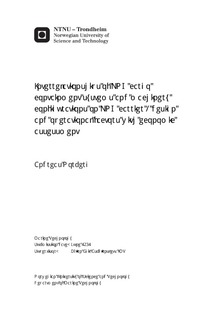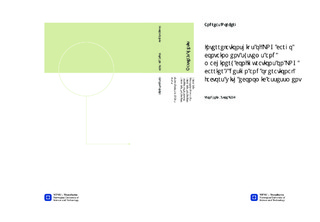| dc.description.abstract | The main objective of this project has been to design a ship for LNG trade between Port Moresby and Singapore, with a cargo capacity corresponding to a total freight work in the range of 1.000,000 - 800,000m3 annually. The main design emphases have been on propulsion- and cargo handling systems.
The project is divided in to three parts. The first part gives a thorough investigation into design theory and design optimization methods. The second part gives description of current state of the art within LNG carrier designs and technical interrelationships in ship design. The third part contains the ship design process, following the systematic approach illustrated below.
Based on a qualitative analysis of the most promising containment systems offered in the market, LNT A-BOX was found favourable. The LNT A-BOX consists of an independent tank type A as primary barrier, with liquid tight thermal insulation connected to the hull compartment as secondary barrier, resulting in a fabrication friendly and cost effective design with access to both primary and secondary barrier for ease of inspection and repairs.
The insulation system is built up by two layers of insulation and can either consist solely of polyurethane foam, polyurethane panels or expanded polystyrene panels or a combination of these. No obvious benefits of each insulation material were clear, so six different insulation systems were determined for further investigations.
Based on the given trade rout, a cargo capacity within the range of 35,500-49.000m3, divided in three equal sized cargo tanks, were found necessary to meet required annual freight work as well as damage stability requirements. The physical parameters of each cargo tank were furthermore determined by dimension ratios from previously built IMO A tanks in combination of with free board evaluations on existing gas carriers. A maximum allowable insulation thickness of 1040mm was set as constraint when determining required cargo hull compartment size. The cargo compartment size was furthermore used as basis in the ship design process.
In order to determine ship dimensions and hull form, ship statistics and empirical formulas was used. DWT was initially determined from comparison ships with cargo capacities within the same range, and was further used to set initial ship dimensions. Based on initial dimensions, LWT was determined from recommended empirical formulas and coefficients. An idea of required installed power for propulsion was early set by statistics, and weight of machinery systems was determined by weight coefficients. Some ship dimension iterations were performed before final dimensions where set.
Hull form was furthermore determined by empirical formulas and suggestions given in various literatures. Some minor changes where later on changes after determination of main engine alternatives, and during general arrangement modelling in Autocad.
In order to select the best propulsion system for the vessel, evaluation of propulsion systems currently in use on LNG carriers were performed. Thermal efficiency, propulsion efficiency and fuel efficiency was decisive factors in the evaluation process. Slow speed duel fuel and diesel engines with direct drive and fixed propeller were found beneficial and MAN engines were selected.
Required engine output was determined by resistance calculations.
Boil-off handling systems for each propulsion systems have been selected based on recommendations given by engine supplier. In order to determine cost and power consumption of each system, statistics of previously built systems was gathered. Based on engine and boil-off handling evaluation the following ship configurations where determined as favourable for the vessel
Ship configuration 1 2 3
Propulsion system MAN B&W 6S50MEB9 1 set.
SMCR: 10680kW at 117RPM
Direct drive, FPP MAN B&W 6S50ME-GI-B9 1 set.
SMCR: 10680kW at 117RPM
Direct drive, FPP
Boil-off handling system Re-liquefaction plant
+ GCU Gas supply system alt. 1
3 stg. HP compressor
HP fuel pump
LNG vaporizer
+ GCU Gas supply system alt 2
HP fuel pump
LNG vaporizer
Re-liquefaction plant
+GCU
To determine most cost efficient ship configuration a cash-flow model was used and NPV was selected as economic evaluation criteria. Optimal insulation thickness of each insulation material was first identified by using a direct search optimization approach, and optimal insulation thickness was identified from NPV graphs given as function of insulation thickness. Insulation system 1 was identified as the best insulation material for all insulation thicknesses. In order to determine the best ship configuration, ship profitability for each configuration with optimal insulation thickness was estimated and the result is presented in the bar chart below. | |

